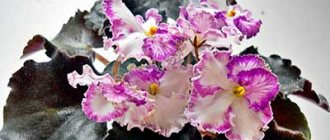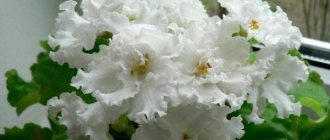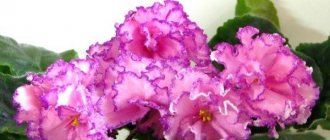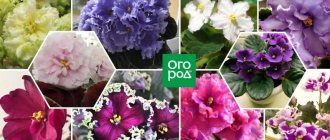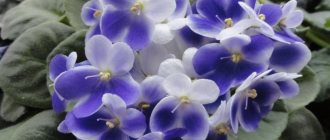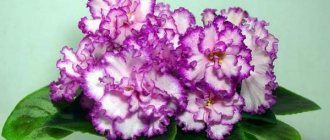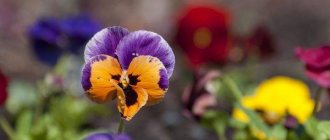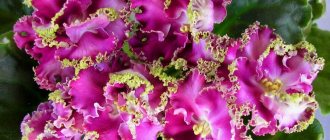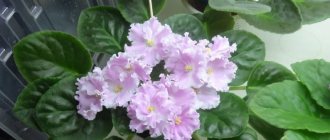Ness Orange Pekoe (see photo) is a variety with many advantages, one of which is lush cap flowering. This violet has proven itself to be an excellent indoor plant for home growing. However, despite its unpretentiousness, the variety requires compliance with basic rules of care and agricultural technology, because only with due attention will it show its full potential.
Violet, description and photo Ness' Crinkle Blue (D. Ness)
Saintpaulia varieties of foreign breeders “N” (Ness).
Ness' Crinkle Blue (D. Ness).
. (Blue fold).
Half mini. Densely double dark blue stars with a thin white border.
A dark green quilted, scalloped leaf with a pointed tip. Beautiful carved velvet leaves. Almost always neat, ideal rosette - 14 cm, sheet 4 cm.
Recognized as one of the best varieties in the history of selection. Cute terry roses and charming carved leaves. The color of double star flowers is deep dark blue, but not purple. Dark blue roses (3 cm) slowly bloom one after another.
Blue, a nice deep shade that goes well with dark foliage. Scaly form of double flowers. Always blooms very friendly. The flowers were huddled together in a dense bunch, so that they interfered with each other, 9 flowers bloomed, 9 more were in buds. It has weak peduncles that cannot support the weight of the flowers, so they completely cover the foliage and seem to rest on it.
A constantly blooming variety, it blooms almost without rest with luxurious roses. It bloomed in the summer - now it has a cap again. In winter it bloomed with a white border. I don't even remember when it doesn't bloom. Unpretentious, I haven’t noticed any special vagaries, except that it doesn’t like the soil to dry out, then it drops the lower leaves, so the pot with it is regularly checked for soil moisture.
Do you know that…?
In order not to lose your head at exhibitions and meetings of collectors, you need to determine in advance the signs by which you will compose your collection. Some people prefer variegated leaves, some like edges, some admire miniature varieties, some grow only chimeras. There is no need to strive to purchase new items. They are usually unstable and do not always meet our expectations. Let the variety stand the test of time. A novelty is a flower obtained as a result of long selection and several crossings. It can be more capricious than earlier varieties, less decorative, and possessing properties valuable only to experienced collectors.
Before you buy the violets listed below, carefully read the forums about their behavior on the windowsill. Many of them are very beautiful flowers. However, these can be large rosettes with large and fragile leaves, with leaves rising up or hugging the pot, forming many stepsons that interfere with the formation of a neat rosette, pulling the stem up and growing into a Christmas tree, bending the trunk, rare flowering with long breaks, fallen flowers or they last little and quickly wither, very long and recumbent peduncles, the color of the flower fades quickly, they do not like bright lighting on the windowsill, they are afraid of the slightest drying out or waterlogging, a large percentage of them go into sports or darken the flower.
Are they suitable for your window sill and the conditions that you can create for them? You will look at the flowers for several months, and the rosette will always be in front of your eyes. There are many beautiful flowers, there are much fewer beautiful and neat rosettes, look first at the rosette! Search and you may find a dozen violets with the same flower color if you are not interested in the smallest details as a collector.
•— Ness' Fantasy Gold (Ness); •— Ness' Prairie Star (Ness);
Features of growth, flowering and reproduction of violets
For flower growers, this variety of violet does not pose any significant hassle during the cultivation process, as it is highly independent and does not produce strange surprises during development .
Development of violets in indoor collections
The undeniable advantages of retro varieties of violets have already stood the test of time and continue to attract the attention of flower growers who are interested in :
- Easy-going nature and unpretentiousness of the plant;
- Simple perception of the indoor microclimate;
- A neat silhouette and chic pompous decorative appearance.
Among other successful details of the author’s presentation of violets, the following should be highlighted :
- The ability to independently and thoroughly form a harmonious outlet;
- The lushness and dense compactness of a large leafy bush;
- Inconceivable - a bewitching combination of lacy variegated rosettes with brightly corrugated corollas;
- Luxurious, blooming bouquets almost without rest;
- Numerous emerging corollas;
- Calm perception of low light.
Among the unpleasant signs of Saintpaulia, you can pay attention to :
- Frequently exceeding the standard format, which is due to the availability of free space in the collection;
- Loss of brightness of the variegated color of the rosette in a hot microclimate - light lace easily returns in cool conditions;
- Late flowering with strong variegation.
Breeding feature
The important phase of reproduction can be carried out exclusively vegetatively:
- Children from leaves;
- Layering from a mature plant.
The variety reproduces well.
The variety exhibits good pecking of a mass of babies .
About flowering
CAREFULLY! Varietal corollas can be called resistant to hot conditions - they change color only when the petals are exposed to sunlight, although this does not spoil the beauty of the decorative silhouette of the violet.
The violet variety has peduncles:
- Strong structure;
- And the optimal length.
They calmly withstand the weight of the volume of blooming bouquets.
The presented violet variety progressively forms rich bouquets from corrugated corollas.
The corollas of the violet variety retain healthy decorativeness and freshness for more than one and a half months.
What Saintpaulia Ness crinkle blue looks like
Characteristics and features of growing thornless Loch Ness blackberries (loch ness)
This variety of Saintpaulia stands out due to its external characteristics.
Stunning Saintpaulia Ness crinkle blue
It will be no less interesting to learn about the origin of the variety, as well as about other varieties from this group.
Description
Saintpaulia Ness crinkle blue is a semi-miniature variety. The size of the rosette, flowers and leaves is average. The plant is characterized by long flowering with breaks of 1-2 months.
The leaves are dark green, with a serrated edge and a sharp tip. The flowers are double, the petals are arranged in several layers. The color of the inflorescences is blue with a thin white rim around the edge. During flowering, the flower stalks bend under the weight of the inflorescences, lie on the rosette and almost completely cover it.
History of origin and species
Saintpaulias are also called Uzambara violets. Both names are related to the origin of the plant. The flowers were first noticed in the Uzambara Mountains region (Africa), and they were discovered by a local official, Saint-Paul Iller. He gave the seeds to one of the outstanding botanists of that time, Herman Wendland, who gave the flower the name Saintpaulia in honor of its discoverer. He also attributed the plant to the large family of Gesneriaceae.
The crinkle blue variety and many others were developed by breeder Don Nez. At first, he was engaged in crossing gloxinias as a hobby, and became interested in Saintpaulias after visiting an exhibition of Uzambara violets in Sao Paulo. The selection was so successful that the new varieties spread throughout the continent and soon gained worldwide fame.
Violet Ness Orange Pekoe (D. Ness)
Gorgeous violet Ness Orange Pekoe.
IMPORTANT! Phenomenally - an enchanting variety with a neat bush of a rich rosette formed according to the checkerboard principle and inimitable bouquets of corrugated corollas with original tea-coral shades in the color of the petals. It was registered in the lists of AVSA, the main American society of violet growers, by the largest and most authoritative breeder and popularizer of Saintpaulias of the 20th century from Minnesota, Donald Ness, at the final stage of the next seasons of work in the field of breeding tropical beauties.
Donald Ness's penchant for breeding work arose during his experiments in creating new gloxinia. But around the mid-twentieth century (early 70s), the florist switched to growing violets thanks to several specimens of Saintpaulia given to him as a gift.
This variety was bred by breeder Donald Ness.
This was followed by the creation of a family business together with his wife Jean Ness, where constant work was carried out to improve the qualities and images of Saintpaulia, marked by the creation of more than 150 diverse varieties of standards and miniatures.
The violet, which is a decoration and enlivening accent of many home collections, became familiar to flower growers at the very end of the twentieth century as a specimen from the D. Ness line with the abbreviation “Ness” preceding the name of the variety.
Systematic position of the variety
The varietal variation of violet is included in the enchanting heterogeneity of artistic outlines, the powerfully variable genus Saintpaulia, included in the Gesneriev family . A photo of the Ness' Orange Pekoe violet is shown below.
Saintpaulia belongs to the terry and variegated varieties.
Recommended variety of variegated violet:
- According to the category of green mass size, it is included in the segment of large subspecies of standard format;
- According to the structure of the distribution of the number of petals in its flowers to the module of semi-double and double Saintpaulias;
- And according to the color of the rosette, it belongs to the group of variegated leaves.
Photo and description of the Ness Orange Pekoe violet
The variegated violet, which can rightfully be attributed to the classics of retro varieties , in conditions of development in a collection microclimate that is comfortable for it after the final entry into the stage of an adult plant, is celebrated with a ceremonial - magnificent, standard volume of a rationally arranged bush, overflowing with leaves to a highly compacted texture of a tiled silhouette .
The variety is considered large in volume.
ATTENTION! According to the varietal description recorded in the official registers of American Saintpaulia lovers, violets are expected to comply with the parameters of large-standard scales. And flower growers cultivating this variety unanimously confirm the frequent development of cultivated, but extremely large rosettes, which exaggerate their size compared to the upper limits of the intended format for it.
An excellent bonus feature of the growth of violets of this variety is its complete independence , starting from the baby period - plant specimens do not show the need for active involvement of the grower in their physiological processes until they fully mature.
The leaf plates of each bush, enriching the volume of the rosette, are painstakingly and practically without problems distributed by the violet in a canonical order , which, together with the variegated coloring, ensures the creation of a checkerboard-exhibition picture of the plant.
This Saintpaulia grows and develops independently.
Large format violet leaves stand out:
- The texture density is smooth;
- Shiny, slightly leathery surface;
- The shape of an elongated “heart” with a clearly visible highlight of the rounded tip and graphically - a strict venation pattern;
- Attracting attention with a clear structural mesh of thin lateral veins;
- And a slightly enlarged central axis of the salad color.
The edges of the slightly wavy leaves are framed by curly, neatly outlined teeth , emphasizing the openwork texture of the bush.
The presented violet blooms with a lush hat.
INTERESTING! The basic color scheme of the leaves of all specimens of varietal violets is maintained in dark variations of the green palette. Along the contour of the leaf plates there is a decoration in the form of voluminous, lush white lace with pinkish-cream reflections. The size and brightness of variegated leaves vary due to the microclimate conditions in which the green mass matures. The underside of the plates has a reddish texture.
In the described violet, the primary moment of budding occurs at an earlier time than the classic time for the genus. Regular flowering of Saintpaulia is mostly preceded by the opening of single, large-format corollas .
From the second or third time of flowering, violets begin to rapidly form magnificent bouquets of flowers with semi-double, but much more often double, mass of petals in the corollas.
Varietal violets are distinguished by the endlessly long opening of the corollas , which belong to the “pansies” segment, as well as by the delicacy of their texture and the uniqueness of the shades of the color scheme.
The large corollas have wavy petals framed by abundant corrugation of the edges, which, combined with their terry nature, visually further increases the volumetric perception of the bouquets.
NOTABLE! The color scheme of the variety’s corollas fascinates with its varied shades of juicy coral, which can be represented by a palette from pinkish-dusty to orange-tea color. A varietal feature of violets is an age-related increase in the intensity of the orange color, as well as a change in the color of the petals from exposure to sunlight to shades of Peko tea. Within one bouquet, the variety may have flowers with several color options.
Sports of Saintpaulia
was not noticed in the manifestation of sportive flowering .
Transplantation after purchase and during reproduction
Unique violet le-macho (e. lebetskaya)
Transplantation work is carried out by transshipment - so as not to damage the root system. The pot should be 2/3 the size of the flower. The bottom is lined with drainage and a layer of new soil. After moving the violet, the voids are covered with earth.
Important! Replanting after purchase is mandatory - plants from stores are in a poor soil mixture, without the required amount of nutrients. When propagating, leaves with roots need to be rooted in the soil, watered
You can make a greenhouse out of film to accelerate the growth and development of a flower. After the baby is formed, the plants are sent to a permanent pot and transferred to the windowsill
When propagating, leaves with roots need to be rooted in the ground and watered. You can make a greenhouse out of film to accelerate the growth and development of a flower. After the baby is formed, the plants are sent to a permanent pot and transferred to the windowsill.
Allegro Candy Shop, Aly's Blizzard Bunny, Ness' Crinkle Blue, Shino - my mini collection
Home violet
Found a mistake? Report it: 1) Select the error with the mouse 2) Press CTRL+Enter. Read more.
Let me introduce my first miniature violets.
Allegro Candy Shop (J. Stromborg) – Single or semi-double wavy pink stars with dark eye and variable rays; dark green, even, heart-shaped foliage. Semi mini.
Aly's Blizzard Bunny (A.Droege) – Snow-white semi-double star; light green heart-shaped foliage. Mini.
Ness' Crinkle Blue (D.Ness) – Densely double dark blue stars with a thin white border; a dark green quilted, jagged leaf with a pointed tip. Semi mini.
When and how does it bloom
Saintpaulia or violet, Ness crinkle blue has a very long flowering period. Almost all year round the rosette is covered with lush double inflorescences.
During the flowering period, the plant must be properly cared for. Fertilizing should be done at least once every 10 days. It is necessary to prevent temperature changes and protect the flower from drafts.
Important! Under no circumstances should you move a blooming Saintpaulia to another place. During this period the plant is very sensitive.
Reminder for a newbie!
Uzambara (Uzumbar) violet is a plant of the Gesneriaceae family, growing in the natural environment of tropical and subtropical regions of Asia, Africa, Eastern Australia, South America and the Indian Ocean islands.
Saintpaulia is a plant named after the Saint-Paul father and son, who brought a plant unknown to Europeans from the Uzambara district (modern Tanzania) in the 19th century, presented for the first time at the international flower exhibition in Ghent in 1893.
Indoor violet has been one of the most popular plants in indoor floriculture since 1927. By 1949, more than 100 varieties had been bred, and today their number exceeds several thousand.
Rooting
- possibly in water, in substrate, moss.
Priming
- purchased soil or a mixture of leaf, coniferous, turf and peat soil in a ratio of 3:1:2:1 with the addition of raising agents (perlite, vermiculite, river sand, crushed sphagnum moss.
Lighting - it is best to place flower pots on western or eastern windows. To ensure that the plant is evenly illuminated from all sides, the pots are periodically rotated. In winter, when daylight hours decrease, you can use artificial lighting - fluorescent lamps.
Caring is a real art and serious painstaking work at the same time, including watering, fertilizing, and creating a favorable humid climate. Water Saintpaulias as the soil dries. The soil must be moistened regularly, but excess moisture should not stagnate in the roots. When watering, you must ensure that water does not get on the leaves. You cannot water the Uzambara violet with cold water. Fertilizing is done with complex mineral fertilizer once every two weeks. Saintpaulia reacts negatively to a lack of nitrogen in the soil. Optimal air humidity is approximately 50%, temperature is 20-22 ° C, without sudden fluctuations and drafts. The leaves of the plant should not touch the window glass. Removal of faded flowers and damaged leaves is carried out regularly.
Reproduction - planting a leaf cutting, part of a leaf, or a daughter rosette. The most popular method is rooting leaf cuttings. The formation of roots and the development of children lasts 4-8 weeks.
Pests are one of the gardener's problems. There are many different types of pests and it is very difficult to classify them. Among Saintpaulia pests, several groups can be distinguished: mites (spider mites, flat mites, transparent mites, etc.), insects (aphids, thrips, springtails, poduras, scale insects, whiteflies, scale insects, etc.), worms (nematodes).
Diseases - distinguish between infectious (gray rot, powdery mildew) and non-infectious diseases (rotting of the stem and root, wilting of the lower leaves, yellowing, leaf spotting, incomplete opening and premature drying, falling of flowers) of plants. The causative agents of infectious diseases are bacteria, fungi, and viruses. To prevent infectious diseases, you should strictly observe the regimes of watering, temperature, humidity, and lighting. Non-communicable diseases usually arise due to poor agricultural practices. They may appear in one instance and not spread to others.
Peculiarities
Quite large, double or semi-double coral flowers create a beautiful bouquet against the background of an even show variegated rosette. In semi-double flowers, the shape of a simple violet flower is pronounced. The flowers are often double, with 3-5 flowers on strong peduncles. Depending on the conditions, the flowers range from bright coral to coral-fawn. And even on the same rosette, the brightness of flowering can vary. Flowering is frequent and long lasting.
The rosette is smooth and self-forming. The variegation is pink-cream, quite bright on young plants. In conditions of elevated temperatures, variegation can almost completely disappear. But if the rosette is placed in cooler conditions, beautiful brightly colored variegated leaves again appear from the center of the rosette.
The variety loves natural light, but also grows and blooms well on a shelf under artificial light. Propagates well from leaf cuttings and produces a large number of children. Blooms quite early. Blooms profusely and often. This variety is one of the most suitable for beginning collectors.
Reviews
Tatiana Lysikova. I really like this variety too. I can’t say that the rosette is very large... I have a rosette of this variety growing on a wick and on a rack on the bottom shelf. Feels very good, blooms often, flowers last a long time. In cool conditions, variegation appears better. It propagates well and quickly by cuttings and produces many children.
Evgenia Fedoryachenko. The variety is one of the most beloved in the collection, but there are few photographs, since it is very difficult to convey the true shade of the flowers. Even words cannot describe this unique shade - it is pink, and a little coral, and brick at the end of flowering. The variety is generally not capricious, but, like all variegated leaves, it does not tolerate heat well. To maintain beautiful variegation, it is advisable to comply with three conditions - cool conditions, sufficient lighting and regular replanting.
Olga Osipenko. I really like this variety! It has dense dark green leaves. They lay beautifully in tiles row after row. Round shiny. Dark green with white and pink-cream variegation. And all this in combination with bright pink-salmon pansy flowers. In the first year the flowers were very large and very double. The color in the photographs was amazingly correct. And this is just the perfect socket, in my opinion!
What points are important when buying tea?
When purchasing a product by weight, first of all, you should focus visually on the leaves. When a leaf collapses when touched lightly, it means that it is no longer fresh, and there is no need to wait for a fragrant drink
When purchasing products, you need to focus on the aroma: if it is unpleasant, it means that it was treated with chemicals at the time of packaging. flavorings. When purchasing tea bags, you need to look to see if there is a metal clip on the bag. When it is present, the tea will be bad, because iron tends to oxidize, giving the drink an unpleasant taste. You need to look at the date and month you received the leaves: more than three seasons have passed, the drink will become unpleasant. You should be aware of the opening date of the package of tea by weight, because... it has the ability to weather and obtain different aromas.
Features and characteristics of Ness varieties
As a result of many years of work, Don Ness gave the world many varieties of Saintpaulia. Some of them deserve special attention. For example, such as Uzambara violet Ness orange pekoe or antique red.
Crinkle Blue
It is distinguished by almost continuous flowering. Double flowers resemble miniature blue roses. Violet is very unpretentious and easy to grow.
Crinkle blue
Orange Pekoe
Usambara violet Ness Orange Pekoe has double or semi-double flowers in a deep coral shade.
Orange Pekoe
The inflorescences look very decorative against the background of creamy-green and sometimes green-pink leaves.
Satin Rose
Double flowers with a delicate white-lilac color that changes from the middle to the edge.
Satin Rose
The peculiarity of the variety is the coronal arrangement of inflorescences. The leaves have pronounced ribbing and a serrated edge.
Spring Blush
Single and semi-double flowers consist of white petals with soft pink stripes and purple spots.
Spring Blush
Saintpaulia breeders call this color a chimera. The plant is very easy to care for and has long and abundant flowering.
Blueberry Puff
The blue flowers of this variety seem to be decorated with white specks of paint. Outwardly, it looks like the glare of sunbeams on the petals. The inflorescences are dense, up to 15 flowers can be collected on one.
Blueberry Puff
Tiny Flame
Delicate purple double or semi-double flowers contrast against the background of dark foliage.
Tiny Flame
The peculiarity of the variety is a creamy white border along the edge of the leaves.
Pink Confetti
This compact variety of Saintpaulias has original flower colors.
Pink Confetti
The white petals around the edges seem to be covered with splashes of fuchsia paint.
Red Velvet
The flowers are simple, with wavy edges of the petals.
Red Velvet
The velvety scarlet color becomes slightly lighter from the middle to the edge. Violet is easy to care for and simply reproduces.
Angel Face
The flowers are shaped like miniature bells.
Angel Face
Petals with a slight waviness along the edge have a fuchsia tint.
Antique Red
Against the background of dark green foliage, double flowers of rich red color, similar in shape to miniature roses, stand out brightly. Violet blooms almost all year round.
Antique Red
Up to 7 flowers bloom simultaneously on one peduncle.
Fantasy Gold
The color of double flowers simultaneously contains yellow, pink and fuchsia shades.
Fantasy Gold
On each petal they are combined randomly. The leaves are deep green, almost black.
Blueberry Kiss
The variety is distinguished by large flowers of original color.
Blueberry Kiss
The snow-white center turns into the blue edges of the petals. Violet blooms for more than 6 months. The inflorescences form very large.
Photo
Violet Ness' Orange Pekoe, D. Ness. Photo by S. Sazykina:
Violet Ness' Orange Pekoe, D. Ness. Photo: Alena Buryakova:
Violet N e ss' O range P e koe, photo by Evgenia Fedoryachenko.
A young starter (photo from the time when the variety first appeared in the collection):
The same outlet after a year and a half:
Ness' Orange Pekoe, D.Ness, photo by T. Lysikova:
First flowering:
Violet Ness' Orange Pekoe, photo by Olga Osipenko:
And this is the first flowering - the flowers were double:
Photo by Olga Osipenko:
Reproduction
Most often, Saintpaulias are propagated by leaf cuttings. Only healthy and not too young leaves should be used.
Procedure:
- The cuttings are placed in water until roots appear.
- Then it must be rooted in a substrate of peat and sand mixed in a 2/1 ratio.
- After 2-3 leaves appear, they are picked into separate pots.
Propagation by leaf cuttings - quick and easy
For large plants, when replanting, the method of dividing the bush is used. Propagation by seeds is a rather labor-intensive and time-consuming process, which is only relevant for obtaining plants of a rare variety.
Attention! To get seeds yourself, you need to carry out artificial pollination of flowers.
Possible problems in growing
The main difficulties with violets are caused by violations of care requirements.
Plaque, curling of foliage occurs due to:
- rust;
- powdery mildew;
- direct contact with sunlight.
Violet is often attacked by:
- mealybug;
- cyclamen or spider mite;
- aphid.
Diseases
Common diseases include:
- gray rot or botrytis - with a fluffy coating on the surface of leaf blades;
- vascular bacteriosis - with wilting and weakness of foliage.
Important! Most diseases occur due to the use of land from a personal plot or forest park. It contains fungal spores
Fusarium violet
Signs of improper care
Excessive watering causes the following problems:
- loss of attractiveness;
- drooping leaves;
- dull color of leaf blades;
- death of the root system.
Decreased immunity allows insect pests and fungal infections to easily attack the violet. The brown tint of foliage with its massive fall is provoked by fusarium, which develops at low temperatures and excessive soil moisture.
It doesn’t matter what variety of Saintpaulia you decide to purchase. If care recommendations are not followed, the plant will begin to get sick and eventually die.
Possible problems during cultivation
The reasons for the deterioration in the appearance of Saintpaulia can be improper care, attack by pests or diseases.
Improper care
Errors in care include excessive watering, non-compliance with light and temperature conditions. Signs that the plant is experiencing discomfort include the appearance of spots on the leaves or their wilting.
Pests and diseases
Usambara violet Ness Crinkle Blue is susceptible to a number of diseases, such as late blight, fusarium, powdery mildew and various rots. The most common parasites of the plant are aphids and cyclamen mites. At the first signs of damage to the flower, the leaves and soil should be treated, and sometimes transplanted into another pot.
Saintpaulias - flowering and unpretentious plants
Saintpaulia Ness crinkle blue is a beautiful variety presented to the world by breeder Don Ness. His name is also given to such species as Uzambara violet orange pekoe, satin rose and many others. If you follow simple rules for care and maintenance, these unpretentious flowers will delight you with beautiful blooms almost all year round.
Description of the variety
Ness Orange Pekoe is a standard variety developed at the end of the last century and has long become a true classic. The violet was obtained by breeder D. Ness, who gave it a very “English” name in honor of the tea leaf. Despite the obvious associations, the word “orange” has nothing to do with the orange color or oranges - it is an English copy of the name of the dynasty of the Princes of Orange. It was to their court that the best varieties of tea were supplied in the 16th century.
The peculiarity of the Ness Orange Pekoe variety is an ideal symmetrical rosette that forms independently without any outside intervention. The leaves are arranged in dense rows, overlapping each other, due to which the violet looks harmonious. The rosette of Ness Orange Pekoe is large and can become truly gigantic if the plant is not moderately contained with a small diameter pot.
Another pride of this violet is its incredibly beautiful leaves with variegated foliage like Tommy Lou. The main color is dark green, with a pink and cream border clearly visible along the edges
The leaf plates are quite fragile, so during the replanting process you should exercise extreme caution to avoid damaging them.
The variegation is very striking in young plants and also when grown in cool conditions. In hot weather, the pattern may disappear, but when normal temperature is restored, it is restored. Another leaf decoration is festoons, which are complemented by a red underside.
Large flowers are located in the center of the rosette, forming a beautiful bouquet. They can be semi-double or double, and the shade is always as close as possible to red, rich coral. On one strong peduncle of optimal height, 3-5 buds are most often obtained.
The flowering of Ness Orage Pekoe is long and frequent, and the cap can take quite a long time to bloom. The intensity of the color of the buds depends on the conditions of detention - the brighter the light, the more pronounced the orange undertone will be. Good fertilizing is also important for a rich shade.
Ness Orange Pekoe is an easy to propagate variety that produces several strong babies from one leaf. Young plants grow quickly and bloom early. This violet is ideal for beginning gardeners.
Properties
Name
- Original: N e ss' O range P e koe
- Transcription: O ranj P and kou
- Translation: “Tea worthy of the Prince of Orange”
Registration
- Selection: D. Ness
- Year:
Socket
- Socket type: standard
Flower
- Flower size, up to: 6 cm
- Flower shape: pansy
- Terry size: semi-double, terry
- Main color: coral
- Color type: plain
- Border: none
- Other features: no
Foliage
- foliage color: dark green
- foliage type: simple
- foliage shape: round
- reverse side of sheet: red
- leaf edge: jagged edge, (festoons - ?)
- variegation: bordering (Tommy Lowe)
Features of caring for the Ness Crinkle Blue violet at home
If you follow the recommendations, the plant will delight you with its first flowers in 5-6 months. Ignoring the requirements for the regime can cause illness and death of the flower.
Temperature
Violet humako inches - plant features
The optimal indicator is from 20 to 24 degrees. At this temperature, violets bloom massively and for a long time, growing strong and strong.
Lighting
The plant prefers diffused light; if it is lacking, it refuses to bloom. On the sunny side, the violet must be shaded to avoid burns.
Important! In order for the flower to develop symmetrically, it needs to be turned with a new side towards the sun every three weeks
Watering
Produced after the soil dries. Water is poured into the pan, after 20 minutes the excess is removed.
Important! Violet reacts poorly to cold water and liquid getting on the foliage
Spraying
The description states that the procedure can cause rotting of the green part and root system. Spraying is not carried out.
Humidity
The ideal figure is from 50 to 60%. With the right temperature and watering, humidity can be reduced to 30-40% without harm to the flower.
Priming
Preference is given to ready-made store-bought mixtures that are airy and easily retain moisture. Violets need good drainage from expanded clay or foam chips.
Feeding
Liquid complex fertilizers intended for decorative flowering indoor plants are used 1-2 times a month. Fertilizing is combined with watering.
Features of care
Saintpaulias are unpretentious indoor flowers. To admire the beautiful blooms almost all year round, it is enough to follow a few rules regarding care and maintenance:
- Watering is carried out in the pan. To do this, use settled water at room temperature.
- The temperature is maintained at 20-23 °C, the main thing is not lower than 18 °C.
- Lighting is necessary for a long time and intense, but not direct sunlight.
- It is better to purchase ready-made soil, especially for Saintpaulias.
- Mineral fertilizing is applied in the spring and summer, once every 10-14 days.
Violet VaT Tsar Peas - plant features
Caring for Saintpaulias is quite simple. The main thing is to prevent the soil from becoming waterlogged and to provide the plants with good lighting.
Attention! Spraying and wiping leaves is strictly prohibited. To maintain humidity, it is recommended to place the pot on a tray with damp pebbles or expanded clay.
Care
The variation of varietal violets in the setting of apartment collections shows a rather light nature:
The orientation of windows towards sunrise or sunset is especially appreciated by the variety, since with this option it can draw the desired supply of rich natural light without causing harm to itself by burning. It is not advisable to place the flower on other sides: Facing the window opening to the north is dangerous due to lack of illumination - it is advisable to construct artificial illumination with a weakened spectrum; Facing south requires protection from summer overheating for violets. The variety prefers infrequent watering, which is accompanied by monitoring the drying of the substrate in the flowerpot; The situation with the time of adding additional nutrition by introducing the necessary fertilizers will help to resolve the Saintpaulias themselves, visually showing their inner well-being. The same factor will tell you the quantitative and qualitative composition of fertilizers at each stage of violet development.
This agrotechnical procedure should not be abused; The favorable course of the phases of green mass gain and budding of the variety is directly influenced by the mode and structure of lighting of specimens: it is advisable to alternate the duration of exposure to sunlight with exposure to electric lighting with LED devices;
A possible temperature gradient for exotic beauties is desirable within +20 + 24°C; an important point is to prevent its unexpected jumps and sharp drafts; A mandatory requirement when cultivating violets is the provision of fresh portions of the substrate to sufficiently aerate the root system and provide it with better soil permeability; the first priority is to introduce proper drainage;
In conditions of transplantation, it is appropriate to resort to the methodological technique of “transshipment”, which can prevent injury to the roots; The method does not work for diseased violet bushes.
Varieties of Pekoe tea
*OP(pekoe). The presence of caffeine is less than in FOP and FBOP, since the most ancient leaves of the tea bush are used. It has a significant bitterness when consumed. Orange Pekoe (violet pekoe) is a type of tea leaf (orange pekoe tea). *OPA. The largest tea leaves. The leaves of this variety are thicker and larger than OR. The product acquires the most delicate taste characteristics and a unique aroma, and is rated much better than the first variety. *FOP. "Flowery" does not mean "floral". In this category, “Flowery” indicates that there are golden tips. The product belongs to those worthy of leaves that bloomed some time ago, large, perfectly rolled. The product has a more subtle and delicate taste and aroma than OR. The product contains medium-sized whole rolled leaves and contains more caffeine than OP. * FP - Ceylon pekoe tea: leaves rolled into balls. * GFOP (super baked tea). In the list of valuable types of the drink, it contains not silver, but just golden leaves of the plant. The leaves are curled orthodoxly. Even after fermentation, the color continues to be light. This is due to the small amount of tannins included in the composition. Classified as a high mountain tea. Famous for its color (with gold). It takes quite a long time to prepare. The difference with FOP is the large number of tips. * TGFOP. A drink with an increased number of “golden tips”. * FTGFO. There was no significant difference with the previous variety in terms of taste and aroma. However, the number of tips is growing. * STFGFOP. The best FOP product with many “golden tips” of young leaves is a guarantee of excellent quality. This type includes exclusively the best and rarest black tea in the world.
Broken teas (include pieces of individual leaves into the components).
Tips are unopened buds of a tea plant. Contain a huge amount of useful microelements. The presence of tips in tea is a guarantee of a high-quality and healthy drink.
Their classification will be given below. * BOP: This type of product is produced using the same process as large leaf products. The name is most often used in Sri Lanka, Java, South India and China. * Golden Broken Orange Pecoe (GBOP). Second grade broken tea with some tips content. * FBOR. There are quite a few veins. Manufacturers: Assam, Ceylon, Indonesia, China, Bangladesh, South America. * TGBOR. Cut leaves with a number of tips in a golden hue. The result is an aromatic drink of decent strength and amazing color. The same GFOP, but with the highest content of tips. An important variety of Darjeeling and Assam. Fine leaf black tea of excellent quality. * GFBOP - GBOP with the highest content of tips. * TGFBOP - Among the best types of broken tea. From time to time - a blend, for example, a base from Darjeeling with additions from Assam.
Low grade species
* CTC - granular. * F/Fannings - the size of the leaf is smaller than that of the VOR. Brews quickly, good color. * BOPF - often used to make tea bags. The result is an infused product with a bright color. * D/Dust - small specks of dust. It usually infuses immediately. * BOPD is a drink of a smaller group, used for disposable packages. * PD - Peco Dust. * RD: "Red Dust." * SRD - Super Red Dust. * FD: "Fine Dust." * SFD - Super Fine Dust. * GD - Gold Dust.
The quality of the drink in China is meant by designations from 1 to 7. “Seven” is the worst tea; for the best tea, a rule has been created that it is not “one”, but extra.
